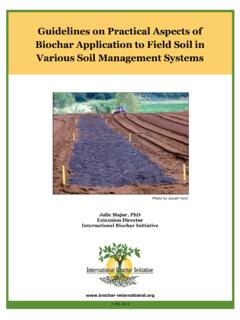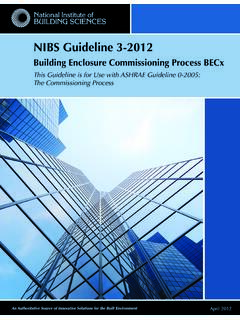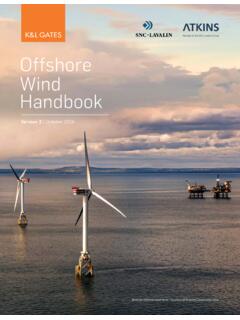Transcription of Guidelines for the Development and Testing of Pyrolysis ...
1 Jane Lynch Technology Extension Director International Biochar Initiative Stephen Joseph Technical Director International Biochar Initiative IBI, 2010 Guidelines for the Development and Testing of Pyrolysis Plants to Produce Biochar Disclaimer: This document has been produced as a guideline to provide advice on equipment design and Testing and biochar application. It is not an exhaustive guideline and does not provide comprehensive evaluation of the potential hazards possible in the design and Testing of Pyrolysis plants. The International Biochar Initiative accepts no responsibility and recommends the use of professional engineers for proper system design . Document Version Information: Ver. , 7 June 2010 Acknowledgements: The authors would like to thank Cordner Peacocke, Robert Brown and KC Das for reviewing and commenting on this material.
2 Guidelines for Pyrolysis Plants International Biochar Initiative Page 3 Table of Contents 1. INTRODUCTION .. 5 Components of Pyrolysis Plants .. 5 2. THE design PHASE SAFE, EFFICIENT, APPROPRIATE .. 6 Sound Engineering design Practice .. 6 Functional Specification .. 6 Develop a Process Flow Diagram and Mass and Energy Balances .. 9 Process and Instrumentation Diagram (PID).. 12 HAZOP Methodology .. 12 Detailed design and Costing .. 14 design Review .. 14 Documentation .. 14 design Checklists .. 14 Health and Safety Considerations .. 14 Environmental Considerations .. 15 Technical 15 Economic Considerations .. 16 Training and Staffing .. 16 3. THE SETUP PHASE - BEFORE Testing STARTS .. 17 Test Location .. 17 Occupational Health and Safety .. 17 Storage and Handling of Feedstock and Biochar .. 18 Preparation of Equipment Required for Testing .
3 18 4. Testing THE PLANT - WHAT DO WE WANT TO KNOW? .. 18 Optimal Feedstock Characteristics .. 18 Operating Procedures that Produce Desired Product Characteristics .. 19 Biochar Produced .. 19 Gas 20 5. OPERATING THE PLANT SAFELY AND EFFICIENTLY .. 20 Feedstock Preparation, Storage, Handling and 20 Start-up and Shut-down .. 20 Page 4 Guidelines for Pyrolysis Plants International Biochar Initiative Operation and 21 Unloading, Storage and Handling of Biochar .. 21 Maintenance .. 22 6. DATA COLLECTION .. 22 Measurement Equipment Required .. 22 Data Collection: Inputs .. 23 Running the Equipment: Conditions and variables .. 23 Data Collection: Outputs .. 23 Quality Control .. 24 Eco-toxicity Testing .. 25 Germination Testing .. 25 Adsorption and Cation Exchange Capacity Testing .. 25 Agronomic Testing .. 25 Field Trials.
4 27 Data Analysis .. 27 7. APPENDICES .. 27 APPENDIX A:EXAMPLES OF ENVIRONMENTAL PROTECTION 27 APPENDIX B: GASIFIER Testing .. 28 APPENDIX C: BASIC DATA ANALYSIS .. 28 APPENDIX D: PROCESS INSTRUMENTATION DIAGRAM .. 30 REFERENCES .. 30 Guidelines for Pyrolysis Plants International Biochar Initiative Page 5 1. INTRODUCTION This document was produced to assist in the Development and Testing of small Pyrolysis plants and provides advice on equipment design and Testing as well as the specification and Testing of the biochar product. The International Biochar Initiative encourages innovation and Development of biochar production technologies at all scales. Because there are personal and environmental health and safety risks inherent in producing biochar, IBI has developed these Guidelines to assist in the safe and effective Development and Testing of biochar production technologies.
5 The top concerns are to: Ensure the safety of equipment operators and the general public Minimise emissions of atmospheric contaminants Produce biochar that is suitable for soil application (refer to documentation of International Biochar Initiative s Characterisation Workgroup for parameters). IBI seeks to promote biochar for environmental management and biochar production methods which are safe and beneficial for people and the environment. You can find more information about the IBI and about biochar at the IBI website: Components of Pyrolysis Plants Pyrolysis is the thermal degradation of biomass under the absence of oxygen. Pyrolysis results in three products: biochar, non-condensable gases and condensate (tars and water). The proportion of each is a strong function of the feedstock and the operating conditions of the pyrolyser. Some systems (slow pyrolysers) focus on biochar production with syngas as the major co-product, while other systems (fast pyrolysers) focus on bio-oil (condensate) production with biochar as the major co-product.
6 These Guidelines focus on slow pyrolysers. Depending on the size and complexity of the Pyrolysis plant, the main components of a Pyrolysis plants include: pre-processing equipment ( grinding, drying, chipping, sieves or screens), materials handling (belt conveyors, storage bins) and feeding equipment (feed screws, lock hoppers, feed belts), dryer (as required), biochar kiln, burners including syngas burners, gas cleaning, cooling and/or quenching equipment, instrumentation, and electrical equipment including generators. The outline of a Functional Specification for Pyrolysis Plant in provides an example of the scope of components which may be part of a plant. The Process Flow Diagram in and the Process and Instrumentation Diagram in provide illustrations of different Pyrolysis plants. Page 6 Guidelines for Pyrolysis Plants International Biochar Initiative 2.
7 THE design PHASE SAFE, EFFICIENT, APPROPRIATE Good quality biochar manufactured safely and efficiently starts with good equipment design . The biochar community is growing every day. There are people and resources available to assist with the design process. Others may have experienced similar design issues and be able to share commonly experienced pitfalls, problems and solutions. The potential designer of a plant should be acutely aware that there is a range of Pyrolysis companies operating world-wide, with a variety of experience and technologies. As much use as possible should be made of prior projects, information and publications before starting a design . A good place to start connecting to others interested in Development of biochar technologies is through internet groups such as: Using the following Guidelines on sound engineering design practice will greatly assist in the Development of safe, efficient and appropriate Pyrolysis plants.
8 Sound Engineering design Practice The design process involves the following main steps that will result in a series of documents that together constitute the complete design including design review and documentation: Functional Specifications for the Pyrolysis plant and the biochar product Process Flow Diagram Process Instrumentation Diagram HAZOP ( Hazard and Operability Study) Detailed design and Costing design Review Documentation Functional Specifications A Functional Specification is the documentation that describes the requested behaviour of an engineered system. The documentation typically describes what is needed by the system user as well as requested properties of inputs and outputs. It should be a coherent document, which allows the reader to appreciate how the entire process works and how it is integrated (if appropriate) and which demonstrates what each major unit operation does and how the material flows from the start to the end.
9 In this case we need to develop Guidelines for Pyrolysis Plants International Biochar Initiative Page 7 Functional Specifications for both the plant and the biochar product itself. Functional Specification for Pyrolysis Plant The table of contents of a functional specification could include the following: 1. Introduction This defines the general philosophy behind the overall process, the objectives of plant performance and product quality the plant must reach and the standards that will be used in the design of the plant. Separate functional specifications, in the form of specification sheets will elaborate in more detail the functions of the unit operations that comprise the overall process. This allows the designer, or design team to focus on issues particular to each unit operation. A process flow diagram with all major process streams should be drafted at this time.
10 2. Process Description This may be a simple description or a more detailed analysis of all of the flows of materials and energy through the plant (for more details see Section ). The process description is essential for environmental permitting and to help regulatory authorities to understand the nature and objectives of the process. 3. Major Components (Unit Operations) This will include a detailed specification of the principal unit operations the plant items that comprise the overall process, from feed reception to discharge of products and wastes from the process. 4. Components Supplied by Other Manufacturers Materials Handling Equipment (including the equipment to size, clean and possibly dry the feedstock). Burners (startup, secondary, flare) Instruments Controls 5. Detailed Component Specification Each of the major components will have a number of sub-components that need detailed specification.




